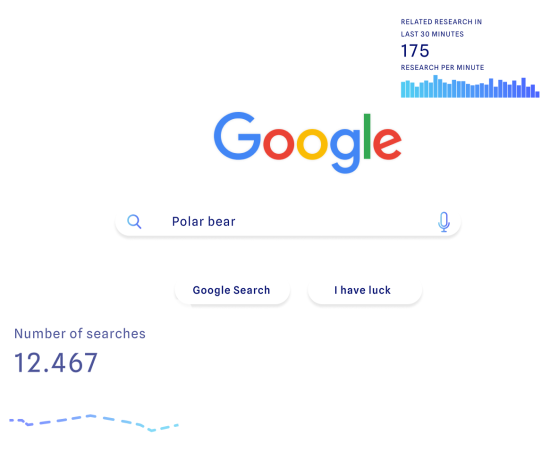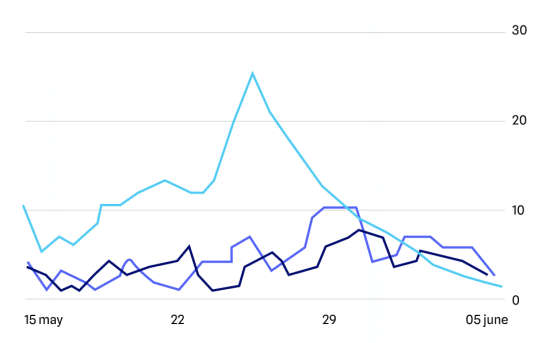
Search Engine Optimisation:
Achieve High and Sustainable Website Rankings!
Is search engine optimisation on Google still a mystery to you? Discover everything you need to know about optimising your website’s ranking!

What is Google search engine optimisation?
What is search engine optimisation?
Search engine optimisation (SEO) encompasses a range of methods and techniques that aim to position the pages of your website in the top organic search results of search engines, including Google, Bing, Yahoo, and others. The objective is to enhance the pages’ visibility by following a set of “rules” known as “guidelines” provided by the search engines. By employing various strategies, it is possible to influence the behaviour of the web-crawling robots that index the pages and ensure they appear more prominently in response to user queries.
How does the Google search engine work?
Google indexes billions of pages every day and ranks them to determine their position in the search results. Before indexing, there is the process of “crawling”: where Google’s robots explore all web pages. If the conditions are met, a page is indexed and stored in the database. It is then positioned in the search results. For instance, when someone searches “SEO agency” on Google, they will receive the pages that best match their query. To determine the relevance of pages, Google has established hundreds of criteria, and it is these criteria that Google’s SEO aims to apply.
What sets SEO apart from paid indexing?
SEO aims to position pages in the “organic” or “natural links” results of the search engine results pages (SERPs). This positioning is achieved without the need to pay the search engine, unlike paid indexing (SEA). This involves purchasing keywords to display “sponsored links” at the top of the SERPs, such as through a Google Adwords campaign. Payment is made through an auction system, with prices varying widely depending on the competitiveness of the targeted keywords.

How do Google updates work?
Google’s algorithms are continuously evolving to provide users with the most relevant results. These updates can vary in impact, with some being minor changes like mobile compatibility and HTTPS protocol, while others are considered major updates that significantly affect Google’s SEO and positioning criteria. The purpose of these algorithms is not only to assess the relevance of SEO but also to penalise websites that employ abusive SEO techniques (we will discuss penalties in more detail later). Here are a few examples of the most important updates:
-
Google Penguin
This Google update focuses on the quality of backlinks, which are incoming links from third-party websites pointing to the pages that need to be optimised.
-
Google Panda
This update emphasises the quality of web content by considering its relevance to user expectations.
-
Google Hummingbird
Hummingbird is the first in a series of updates aimed at better understanding user intentions. It was followed by Google RankBrain.
-
Mobile-Friendly
This update prioritises mobile-compatible websites, and Google provides a Mobile-Friendly Test to check the level of compatibility of your site.
What is local SEO?
Local SEO is a branch of Google’s search engine optimisation that aims to position businesses in response to location-specific queries, usually accompanied by a city name. For example: “SEO agency in Paris.” The goal is to reach local customers when they are actively seeking information about a particular service or product. It’s worth noting that 25% of all searches on Google have a local intent, and a staggering 88% of location-based searches conducted on smartphones lead to some form of action, such as a phone call or a physical visit, within 24 hours. An essential aspect of local SEO is the Google business listing (previously known as Google My Business), which provides a straightforward and effective way to showcase a company’s contact details, operating hours, and geographical location through Google Maps.
Why is search engine optimisation essential?
Why is SEO on Google necessary?
Because Google is the most widely used search engine worldwide. Its market share ranges from 75% to 95% depending on the country, with an average of 91.8% (source). In France, over 91% of internet users primarily rely on this search engine. Working on your SEO is crucial as it increases the visibility of your web pages to users and helps generate a larger volume of traffic to your website.


Search Engine Optimisation:
A matter of visibility
Visibility is the key to success on the web. Consider that there are nearly 2 billion websites on the internet, and Google has indexed around 130 trillion pages. Moreover, Google’s robots (known as Googlebots) visit approximately 20 billion websites each day. In such a competitive landscape, the only way to make your page visible to users conducting searches is to optimise it according to the search engine’s guidelines.
What makes Google search engine optimisation the primary driver of digital traffic acquisition?
Search engine optimisation enables you to attract qualified traffic to your web pages, which can potentially convert into prospects and, ultimately, customers. By improving your SEO, you have the opportunity to capture the attention of individuals who are genuinely interested in the specific services or products you offer. The beauty of traffic generated through Google SEO lies in its longevity—it continues to drive results over the long term. Unlike traditional advertising campaigns that cease to deliver outcomes once the funding stops, SEO keeps attracting traffic (and generating profits) even when you’re not actively fine-tuning it.

What constitutes a Google search engine optimisation penalty?
Webmasters who disregard Google’s guidelines run the risk of incurring penalties from the search engine. These Google SEO penalties arise from algorithm updates. For instance, the Penguin penalty acts as a filter to penalise websites with low-quality backlinks. On the other hand, the Panda penalty targets sites with content that falls short of the expected quality standards, such as keyword-stuffed pages. These penalties can be algorithmic or manual, with decisions made by Google engineers. In their fundamental guidelines for webmasters, Google provides a list of techniques to avoid in order to steer clear of penalties.
How can you tell if your website has been impacted by a Google penalty?
Google penalties can have significant consequences for your website’s ranking, including demotion, deindexing, or even being blacklisted. It is therefore important to respond swiftly in case of a penalty and, to do so, you need to promptly assess the situation. How can you determine if your site or certain pages have been penalised due to abusive Google SEO practices? There are two ways: either you receive a notification through Google Search Console (for manual penalties), or you observe changes in the ranking of your pages or a sudden decline in generated traffic (for algorithmic penalties).

How to improve your website’s SEO?

-
Search engine optimisation and its many levers
While the concept of SEO is relatively straightforward, its practical application can be complex. This is because optimising your website’s SEO involves utilising a significant number of levers (over 200) that align with Google’s established criteria – the famous guidelines. To assist webmasters in getting started, the search engine provides the Google SEO Starter Guide. However, it’s important to note that this guide primarily offers foundational SEO principles. It is up to each individual to interpret Google’s algorithms in their own way and develop a cohesive SEO strategy, considering both on-site and off-site SEO levers.
-
What is on-site search engine optimisation?
On-site SEO encompasses all the elements related to the web pages themselves. This includes technical factors (such as loading speed, mobile compatibility – responsive design, URL structure, and rich snippets), content-related factors (such as keyword selection, placement, semantic fields, content quality, and originality), and factors that facilitate the crawling of robots and their understanding of the pages (HTML tags: title, meta description, heading levels Hn, alt attributes for images; robots.txt and sitemap files; internal linking). While these elements impact a page’s SEO to varying degrees, they contribute, at the very least, to its proper indexing and potential improvement in visibility.
-
What is off-site search engine optimisation?
Off-site SEO, also known as netlinking, encompasses all the external elements related to web pages. These SEO factors include the site’s popularity, netlinking, and backlinks (links pointing to your pages from other websites), competitive benchmarking, and social links. The main driving force behind off-page Google SEO is quality: a page that appeals to users will more easily attract inbound links and increase its popularity. For instance, ten backlinks from influential sites hold more significance than 100 backlinks from sites with a poor reputation. Therefore, it’s crucial to prioritise high-quality inbound links—preferably natural ones—and pay careful attention to link anchors.
-
Why is it important to measure your audience?
Since the goal of search engine optimisation is to improve website visibility and increase traffic, it’s essential to measure the volume of this traffic. This is a fundamental requirement for evaluating the effectiveness of your SEO campaigns and identifying any potential roadblocks. Key tracking indicators include overall website traffic, the most visited web pages, pages with the highest visitor-to-prospect conversion rates, and the referring domains from which traffic originates (sites that users click on to access your pages through backlinks). There are numerous tools available, such as Google Analytics, to measure website traffic accurately.
-
Strategies for international search engine optimisation
SEO strategies are no longer limited to a single country. For businesses operating in multiple markets, it is advisable to focus on Google’s international SEO to reach a wider audience. This can be achieved by making your website multilingual, entrusting content translations to professionals, targeting country-specific keywords to improve visibility on national search engines, ensuring URL structure aligns with local preferences, and considering collaboration with an international SEO specialist. By implementing these approaches, you can effectively enhance your international SEO efforts and expand your online presence across various markets.
How to develop a search engine optimisation strategy
How does an SEO audit work?
An SEO audit is a crucial first step in any Google search engine optimisation strategy. This preliminary process helps determine the best course of action based on various factors specific to your business and website. During an SEO audit, key elements such as keywords, competitive analysis, website performance in organic search, site architecture and content, technical aspects, and the quality and extent of backlinks are examined. While specific tools are used to analyse technical issues, the strategy itself is where an SEO consultant’s expertise comes in. There’s no one-size-fits-all SEO strategy or secret recipe that works universally for all websites. An organic search audit is essential for constructing a tailored strategy that meets your unique needs.


How to choose keywords for your Google SEO?
Selecting the right keywords is among the most critical aspects of SEO. It depends on your industry and specific requirements. Keywords are chosen based on their popularity (the number of times users have searched for them) and competitiveness. However, it’s important not to solely target overly popular queries. While it may be challenging to rank for generic keywords in certain industries (e.g., “SEO agency”), focusing on long-tail keywords generally proves to be more manageable and generates highly targeted traffic that is more likely to convert. Various tools, including Google’s Keyword Planner, can assist you in selecting your keywords.
Why is it advantageous to use the “long tail” approach in search engine optimisation?
The term “long tail” refers to longer, more specific keyword phrases consisting of 4 or 5 words or more. It allows you to target precise and qualifying search queries, like “SEO agency located in Paris” instead of simply “SEO agency.” These specific keywords may not be as popular but they face less competition. The benefit? They enable better positioning within the SERPs for queries that have a higher conversion rate. It’s important to note that the rise of voice search, driven by mobile device usage and smart speakers like Google Home, amplifies the significance of “long tail” queries. Hence, implementing a tailored Google search engine optimisation strategy is highly recommended.

Why does an SEO strategy take time?
With over 200 optimisation criteria, Google’s search engine optimisation demands expertise, experience, and most importantly, time. In reality, achieving tangible results from a website’s SEO strategy requires a long-term perspective. It typically takes around 6 months to witness positive impacts, considering various tasks such as conducting an SEO audit, formulating an action plan, implementing changes, optimising on-page elements, publishing high-quality content, and building authoritative backlinks. The advantage lies in the long-lasting effects generated by the implemented strategy, even after it has been discontinued. In essence, SEO can be likened to a diesel engine: it takes a while to get going, but its effectiveness endures over time!
Why should you entrust your SEO to an external service provider?
At this point, you’ve come to understand that Google search engine optimisation is a complex and multifaceted approach. Therefore, implementing a relevant and effective strategy requires specialised skills, specific expertise, mastery of essential tools for conducting audits, identifying the right keywords, and staying constantly updated on the evolving criteria set by search engines. Unless you have an in-house team of SEO experts, it’s more efficient and cost-effective to enlist the services of an external provider, such as an SEO agency, to optimise your website’s search engine rankings.


How much does a website’s SEO strategy cost?
The cost of your website’s SEO depends on various factors, including your industry, specific needs and constraints, the level and nature of competition, your business objectives, and the size of the website in question. You may also require a website overhaul or migration. Therefore, the budget can only be determined through a thorough SEO analysis that takes all these parameters into account. However, as a rough estimate, expect to allocate around £15,000 per year for a small to medium-sized enterprise, which represents an average budget, and several thousand pounds per month for larger businesses. Of course, it’s important to not only consider the cost itself but also evaluate the return on investment of this strategy, which happens to be one of the highest in web marketing!
Our Commitment
-
Expertise
Since 2010, we have worked with over 2000 clients across 90 countries.
-
Passion
We are a team of passionate, industry-focused individuals who are committed to your success.
-
Performance
We’re committed to implementing a data-driven strategy, making a real impact on your bottom line by providing avenues for growth.
Any questions?
Search engine optimisation (SEO) encompasses all the methods and techniques aimed at positioning the pages of your website in the top natural search engine results. An SEO strategy involves nearly 200 factors to consider, both on-site (directly optimising the website) and off-site (taking into account external factors, including backlinks).
The initial results of an SEO strategy typically appear between 4 and 12 months after the start of the SEO service, according to Google. To solidify positions in the search engine results page, SEO needs to be approached with a long-term perspective. The good news is that the benefits of SEO are long-lasting!
The cost of an SEO strategy varies depending on the industry, website size, scope of work required, market competitiveness, and targeted keywords. The average budget for a small to medium-sized enterprise is around £15,000 per year. In return, SEO is the most cost-effective digital acquisition strategy!












